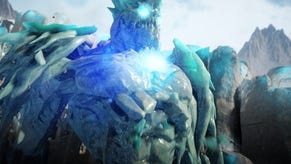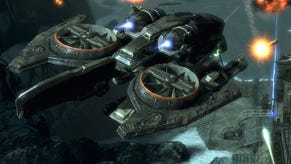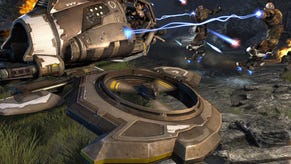Unreal Tournament III
Suck it down! Wait, that's the other one.
Unreal Tournament III? The other ones were on the PC, Mr PS3 Consumer. Of course you know that (I've always liked you), but some won't. That's the point; it was huge on PC, and Epic and Sony know that PS3's spangly new online network and ferocious hardware is ideal for establishing it properly away from its usual digs. So if you are new, the premise is this: a multiplayer-focused first-person shooter that takes established concepts like deathmatch, team deathmatch, duels and capture the flag, aims to do them very well, and moulds them into tweaked alternatives to establish variety.
When he wrote about the PC release, Jim began with the "feel", and that seems like one of the two or three most important points of discussion between Unreal Tournament III on its home turf and this ambitious US Christmas release on Sony's latest shelf-bending entertainment obelisk. There are a few elements to this. First is the control layer, obviously - and Epic has given us options there, with Sixaxis control the default but support for a USB mouse and keyboard combination for purists.
Except surely purists will be playing it on the PC? Well, they probably should. Mouse and keyboard here feels a bit imprecise. It works, but side-by-side comparisons may concern the aforementioned purists who aren't reading this anyway, and strangely input's only active in-game, with menus having to be navigated by the regular pad (probably one of those TRC things). Fortunately the Sixaxis does a splendid job if you use it for everything. FPS games are tricky to get right on a console, and the fact Halo did so well on its first attempt is one of the main reasons that game is so revered by Xbox owners. UT3 is another good example, with options to tweak sensitivity and turn-acceleration. The Sixaxis' motion-sensing makes an appearance too but in a slightly throwaway implementation that I disabled fairly quickly. Another thing to note is that the server browser can be ordered to exclude keyboard-and-mouse battlers.
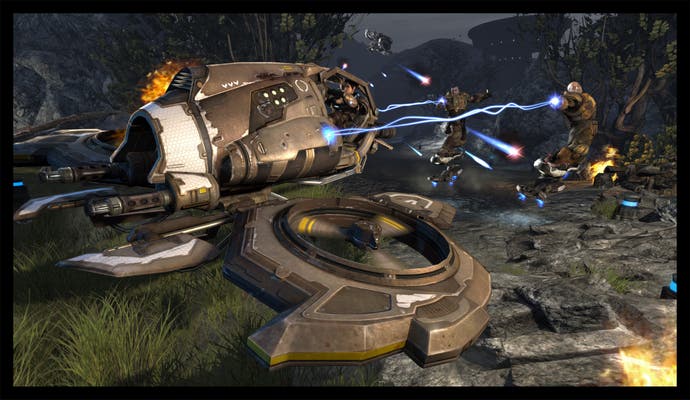
The other part of the feedback loop Jim described to sum up feel is from the screen back to the player. Solid, chunky and fast, basically. Characters are like those in Epic's other colossus, Gears of War - there are certainly more than a few passing resemblances to Theron Guards, Locust troops and Marcus, Dom and Cole Train in how they appear and dress - and with that you're getting a feeling of gritty burliness when you're amongst other players, rather than the spindliness of some of the players you'd encounter in Resistance: Fall of Man or TimeSplitters. There's a fair amount to aim at, the sight of projectile impact (particularly the pacey rockets) is terrific, and everything you intend seems to happen with the ever so slightly absurd brutality Epic's last couple of releases have focused on. It's a bit like watching bodybuilders go paintballing, except the paintballs blow them into abstract husks of ribcage and improbable ketchup spills of lumpy organic refuse which disappear before any of it has a chance to corrupt your senses. There's certainly no Manhunt objection here - visually this is to real life warfare as Twiglets are to wood.
So we can say it feels good. It handles well, if you like. I had expected to go into bouts of the more complicated game modes like Vehicle CTF and Warfare - both of which we'll come to presently - with a certain amount of trepidation based on the typically different curve of difficulty on a pad-based FPS control scheme, but with the tweaks and success elsewhere in the loop it wasn't the case. A lot of that is to do with Epic's considerable talent for building arenas and a few sign-posting elements. Starting offline with the single-player campaign, you're given narrated overviews of each game mode as you begin, and there are trails of arrows to direct you between the significant objectives where it might otherwise be daunting. By the time you've conquered the first half-dozen tasks, any hint of trepidation has gone. It's certainly not that the computer-controlled bots give you an easy ride either - Epic's capture of talented AI designers early on in its life continues to pay off, with adversaries and team-mates who behave just as agreeably as most of the real-life players stumbling around online.
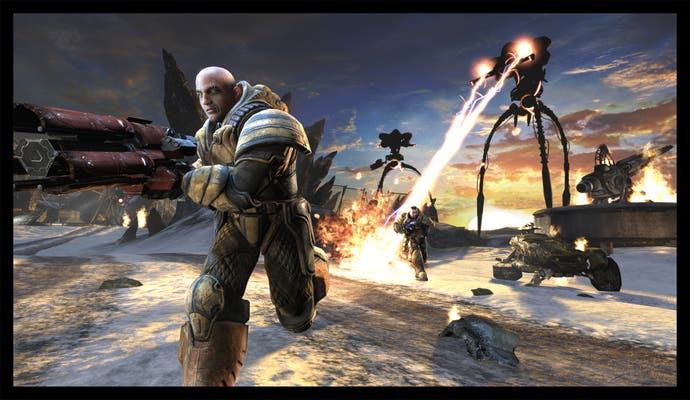
Vehicles, weapons, arenas, controls - it's all very intuitive, could probably survive without the added layers of instruction, and significantly still feels natural when the diversifications from standard multiplayer FPS modes and equipment are asked to work together. Warfare is a splendid mode - I always found the old Domination mode, where you simply fight to control capture-points as a team, rather dull, probably because I've a tendency to want to take full control of the scenario myself, but Warfare doesn't present this problem because everyone 'gets' it quickly, and the dynamics of each element are engaging.
The idea is to capture, reinforce and defend central nodes to allow others to break through to the enemy stronghold and destroy their core. Extra nodes allow control of vehicles and turret guns on rails. Capturing, reinforcing and defending the pivotal nodes between opposing cores is a deceptively basic act rife with important considerations; the other side might try to push to the node with an orb that allows for its immediate capture, or they might try and take it down with the maximum possible strength of numbers, while your protection needs to include pumping the node with replenishing Link Gun rounds to stop it falling into neutrality, where a brush from an opposing team player would rotate ownership to them. Even the little design decisions, like forcing you to suicide to destroy an enemy's node-capturing orb if it's dropped, or waiting for it to slowly expire, speak to a lot of well-judged absorption of feedback from testing.




